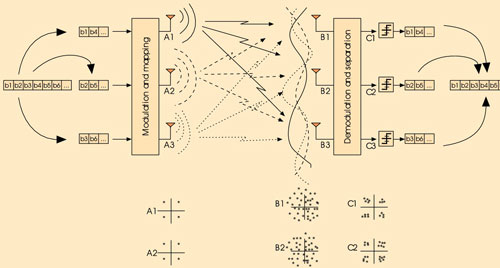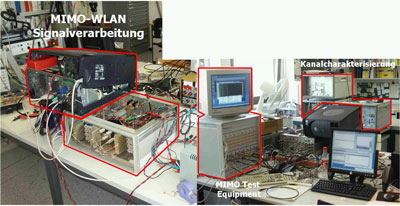|
|||||
Real-Time MIMO Testbed for Next Generation Wireless LANsby Andreas Burg and Helmut Bölcskei At ETH Zurich, a MIMO-WLAN (Multiple-Input Multiple-Output Wireless Local Area Network) system has been developed and demonstrated successfully in a test setup. Four antennas at the transmitter and at the receiver boost the data rate from 54 million bits per second (Mbps) in a regular 802.11g-based WLAN to up to 216 Mbps. In addition to the higher throughput, the system provides increased link reliability and better coverage. With the establishment of the IEEE-802.11a/b/g standards, wireless computer networks have started to gradually replace regular wired Internet access in homes, offices, and public areas, such as train stations and airports. However, as only limited bandwidth is allocated to be used by such systems, data rates need to be shared. As the number of users grows and applications become more demanding in terms of throughput and link reliability (quality of service), current standards can no longer meet the requirements. Multiantenna (MIMO) systems are a means to increase the data rate, link reliability, and range of all kinds of wireless networks and mobile communication systems, without increasing bandwidth and/or transmit power. Three main effects are responsible for this performance gain: The 'diversity gain' stabilizes the link, as the additional antennas can be used to compensate for a weak connection on any of the other antennas. The 'array gain' allows the receiver to pick up more of the energy that was radiated from the transmitter, effectively increasing the range of the system. The 'multiplexing gain' finally allows transmitting multiple data streams concurrently in the same frequency band, thereby effectively increasing the data rate. A schematic of such a system with three antennas is shown in Figure 1. The high-rate data stream is first partitioned into three lower rate streams, which are then sent simultaneously from the individual antennas, using the same frequency band. At the receiver, three antennas pick up the superposition of the streams, and a suitable decoder separates them again and reconstructs the original high-rate stream.
Researchers at the Communication Technology Laboratory and at the Integrated Systems Laboratory of the Swiss Federal Institute of Technology (ETH) Zurich are working on the development of such MIMO (Multiple-Input Multiple-Output) systems and on their integration in today's WLAN systems. Research activities focus on both the theoretical analysis and the VLSI implementation of such systems. At the Communication Technology Laboratory, the limits of multiantenna systems are investigated, and new algorithms that approach these limits in practical systems are developed. The additional degrees of freedom induced by multiple antennas can be exploited by different algorithms, which need to be tailored to individual application scenarios. The implementation complexity of these algorithms generally exceeds the complexity of algorithms applied in single-antenna systems significantly. For this reason, researchers at the Integrated Systems Laboratory are concerned with algorithm optimization and efficient implementation in application-specific integrated circuits (ASIC). The challenge is to meet throughput requirements while maintaining a small chip area to reduce cost and to guarantee low power consumption. A recent example of this joint effort is the development of a decoder ASIC (sphere decoder) that allows the optimum separation of parallel data streams, received on multiple antennas.
Within the scope of a three years project, financed by the ETH research council, a real-time demonstrator for a MIMO-WLAN system with four antennas each at the transmitter and the receiver has been developed. The system boosts the data rate of a current single antenna IEEE-802.11a WLAN system to 216 Mbps, without the need for additional bandwidth and/or transmit power. Such initial practical experiments allow researchers to test new algorithms in real-time and in real-world scenarios. They are also indispensable contributions to standardization efforts (eg, the ongoing work in the high-throughput 802.11n working group) to identify implementation bottlenecks and other pitfalls that might appear in their hardware realization. Recently, first over-the-air experiments have been carried out, indicating that the predicted gains are in fact achievable and that the proposed system can be realized with manageable hardware complexity that will eventually allow integration into a laptop computer or personal digital assistant (PDA). Please contact: |
|||||




